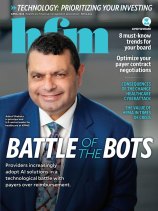HFMA’s Fifer, international panelists discuss how to improve investment in health
- HFMA President and CEO Joe Fifer took part in an international summit that included a session on bolstering community health through appropriate investment strategies.
- Rather than being funneled to healthcare operations, spending should shift to addressing social determinants and root drivers of health outcomes.
- Clarifying the ROI is crucial in any effort to promote targeted health investments.
- Fifer’s participation in the summit was part of HFMA’s new international strategy.
It’s time to recalibrate strategies for investing in health and healthcare, HFMA President and CEO Joe Fifer, FHFMA, CPA, explained recently as part of an international panel discussion.
“The paradigm shift that’s necessary in the United States is to spend smarter and not necessarily more,” Fifer said, noting that 18% to 19% of GDP already is spent on healthcare.
Fifer made the remark Sept. 1 during the virtual H20 Summit, an event produced by the G20 Health & Development Partnership. In the U.S., he added, statistics show $6 out of every $7 in healthcare spending is on treating chronic conditions and related complications.
Furthermore, half of all spending is on about 5% of the population, including people with multiple chronic conditions. During the COVID-19 pandemic, underlying health issues have been linked to more severe illness and worse outcomes in those who contract the disease.
The spending ratio might not be quite as stark in other developed countries, but in general, 20% of the population accounts for about 80% of health-related spending, said Rifat Atun, MBBS, MBA, professor at the Harvard University School of Public Health, who led the panel discussion titled “Paradigm Shift on the Economics of Health.”
“We need to reallocate our health spending toward improving chronic condition management and preventing the development of chronic conditions in the first place,” Fifer said.
Fifer sees an imbalance in that 90% of expenditures are on healthcare rather than on addressing social determinants of health. Finding solutions to entrenched issues such as food and housing security will require an evolution of the skill sets that drive successful healthcare organizations, he said.
“Things like workplace communication, organizational development, cultural competency, behavioral science, all of those things that are rooted in psychology and sociology,” Fifer said. “Those are the kinds of things that would foster collaboration between [the] public, private and technology sectors and also increase trust between all those sectors and the people who are within those sectors.”
The mindset is changing
When the H20 Summit launched three years ago, said Alan Donnelly, convener of the G20 Health & Development Partnership, the words “investment and health were never used in the same sentence. Health was seen as expenditure, not as investment.”
A new model is required in which health becomes the centerpiece of public-private investment strategies, not something that takes a backseat to economic objectives. “Health for all has to be the overall mission, the moonshot, the goal — and the economy has to be restructured to serve it,” said Mariana Mazzucato, PhD, chair of the Council on the Economics of Health for All, a World Health Organization program.
Fifer noted that clarifying the ROI is crucial in any effort to promote targeted health investments.
“I’ve seen too many examples in my career of the right thing to do, but those ideas die on the vine because there’s no return on investment,” he said. “I think [a] balanced conversation about the impact on the economy, the impact on health and the right thing to do is a really powerful thing.
“Quite frankly, that perhaps would broaden the acceptance of spending more — and smarter — on health.”
A new paper by the WifOR Institute, an international think tank that was represented on the panel, proposes common metrics with which to “assess health investments, measure their impact on economic growth and societal well-being, and ensure health and financial resilience.”
Health investment strategies that work
Fifer cited the example of Geisinger, a Pennsylvania-based system that refers to itself as a health and wellness organization rather than as a provider of healthcare.
“They’re directing their efforts primarily toward resources to improving nutrition, physical activity, housing, transportation, social isolation, reducing unhealthy behaviors, those kinds of things — reducing if not eliminating the need for hospital care,” Fifer said.
Geisinger’s capacity to pursue this model stems in part from its ownership of a health plan, which aligns financial incentives with efforts to limit healthcare utilization as appropriate. The organization also centers its approach on “thinking more broadly … collaborating with all kinds of groups,” Fifer said.
Examples also can be found outside the healthcare industry. Based in Orlando, Rosen Hotels & Resorts is a self-insured company that provides in-house primary care and lab and diagnostic testing for almost 6,000 employees. Copays for primary care visits are $5, and most generic medications are no-cost.
The company also offers incentives for employees to choose healthy foods, covers state college tuition for employees and dependents, and pays for daycare and preschool activities.
Fifer said such investments have helped Rosen save $400 million in healthcare costs over 30 years and keep per-member-per-month spending at about half the level of an employer with traditional group insurance.
“That’s hard evidence that investment in these social determinants, and doing it broadly across multiple disciplines, has a significant return,” he said.
HFMA launches international strategy
Joe Fifer’s participation in the H20 Summit was part of HFMA’s new international strategy. HFMA’s international mission is to educate the world on leading healthcare finance practices that improve the lives and health of citizens and maintain sustainable healthcare systems.
HFMA’s international activities include membership in the G20 Health & Development Partnership, which aims to support global health diplomacy, partnerships and policy recommendations within the G20 and G7, as well as membership in the International Hospital Federation (IHF), a not-for-profit, non-governmental organization that promotes international hospital and healthcare organization collaboration. HFMA’s activities with the IHF include chairing a panel at the organization’s 2021 World Congress in Barcelona and developing educational opportunities for the federation’s Young Leaders program.
HFMA also will launch an international membership option that includes access to website content and webinars as well as discounts on curated courses and certifications that are applicable to international markets.





